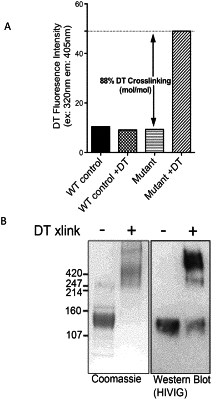| CPC A61K 38/162 (2013.01) [C07K 14/005 (2013.01); C12N 7/00 (2013.01); C12P 21/00 (2013.01); G01N 33/56988 (2013.01); C12N 2740/16051 (2013.01); C12N 2740/16122 (2013.01); C12N 2740/16134 (2013.01); Y02A 50/30 (2018.01)] | 15 Claims |

|
1. A method for producing a vaccine immunogen candidate, the method comprising: (a) producing a recombinant viral envelope protein or viral envelope protein complex in a conformation that can bind to an antibody and can activate a B cell receptor, (b) performing biochemical or structural analysis to identify and select one or more regions in the recombinant viral envelope protein or viral envelope protein complex where the introduction of one or more dityrosine cross-links could stabilize the conformation, (c) introducing into the viral envelope protein or viral envelope protein complex one or more point mutations to tyrosine at one or more of the regions selected in step (b), and (d) introducing into the recombinant viral envelope protein or viral envelope protein complex one or more dityrosine cross-links at one or more of the regions selected in step (b) to form an engineered viral envelope protein or viral envelope protein complex, wherein the engineered viral envelope protein or viral envelope protein complex has one or more properties selected from the group consisting of:
i. enhanced ability to bind to a neutralizing antibody as compared to the viral envelope protein or viral envelope protein complex,
ii. enhanced ability to bind to a broadly neutralizing antibody as compared to the viral envelope protein or viral envelope protein complex,
iii. enhanced ability to bind to and activate B cell receptors as compared to the viral envelope protein or viral envelope protein complex,
iv. enhanced ability to elicit an antibody response in an animal as compared to the viral envelope protein or viral envelope protein complex,
v. enhanced ability to elicit a protective antibody response in an animal as compared to the viral envelope protein or viral envelope protein complex,
vi. enhanced ability to elicit production of neutralizing antibodies in an animal as compared to the viral envelope protein or viral envelope protein complex,
vii. enhanced ability to elicit production of broadly neutralizing antibodies in an animal as compared to the viral envelope protein or viral envelope protein complex,
viii. enhanced ability to elicit a protective immune response in an animal as compared to the viral envelope protein or viral envelope protein complex, and
ix. enhanced ability to bind to and elicit production of antibodies that recognize quaternary neutralizing epitopes in an animal as compared to the viral envelope protein or viral envelope protein complex.
|